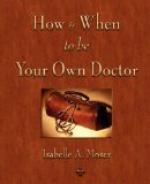A young vigorous body possessing a large degree of vital force will almost always route surplus toxins through skin tissues and skin-like mucus membranes, producing repeated bouts of sinusitis, or asthma, or colds, or a combination of all these. Each acute manifestation will “cure” itself by itself eventually. But eventually the body’s vital force can no longer create these aggressive cleansing phenomena and the toxemia begins to go deeper. When the allopathic doctor gets a patient complaining of sinusitis, they know they will eventually get a cure. The “cure” however, might well be a case of arthritis.
This unfortunate reality tends to make young, idealistic physicians become rather disillusioned about treating degenerative conditions because the end result of all their efforts is, in the end, death anyway. The best they can do is to alleviate suffering and to a degree, prolong life. The worst they can do is to prolong suffering.
Thus, the physicians main job is to get the patient to be patient, to wait until the body corrects itself and stops manifesting the undesired symptom. Thus comes the prime rule of all humane medicine: first of all, do no harm! If the doctor simply refrains from making the body worse, it will probably get better by itself. But the patient, rarely resigned to quiet suffering, comes in demanding fast relief, demanding a cure. In fact, if the patient were resigned to quiet suffering they would not consult a doctor. So if the doctor wants to keep this patient and make a living they must do something. If that something the doctor must do does little or no harm and better yet, can also alleviate the symptoms, the doctor is practicing good medicine and will have a very high cure rate and be financially successful if they have a good bedside manner. This kind of doctor may be allopathic and/or “natural,” may use herbs or practice homeopathy.
The story of Dr. Jennings, a very successful and famous or infamous (depending on your viewpoint) physician, who practiced in Connecticut in the early 1800s exemplifies this type of approach.
Dr. Jennings had his own unique medicines. Their composition was of his own devising, and were absolutely secret. He had pills and colored bitter drops of various sorts that were compounded himself in his own pharmacy. Dr. Jennings’ patients generally recovered and had few or no complications. This must be viewed in contrast to the practices of his fellow doctors of that era, whose black bags were full of mercury and arsenic and strychnine, whose practices included obligatory bleeding. These techniques and medicines “worked” by poisoning the body or by reducing its blood supply and thus lowering its vital force, ending the body’s ability to manifest the undesirable symptom. If the poor patient survived being victimized by their own physician, they were tough enough to survive both their disease and the doctor’s cure. Typically, the sick had many, lengthy complications, long illnesses, and many “setbacks” requiring many visits, earning the physician a great living.




